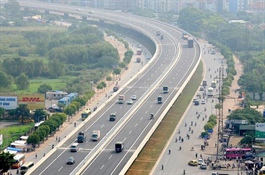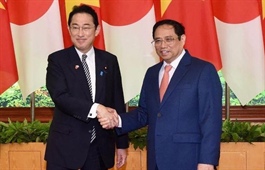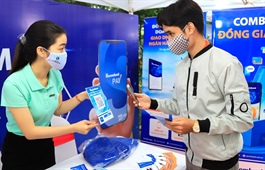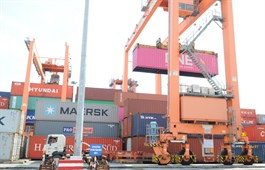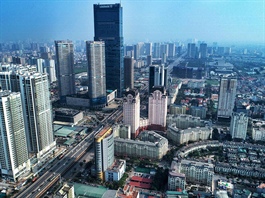PM visit underscores Japanese promise
PM visit underscores Japanese promise
Vietnam’s trade and investment partnership with Japan is expected to witness a new chapter for development, with both nations set to agree on furthering their ties in these sectors painted by strong and fresh commitments.
On April 30-May 1, Japanese Prime Minister Kishida Fumio paid an official visit to Vietnam, further consolidating a new chapter in both countries’ relations. This was his first visit to Vietnam since he became prime minister in October 2021, and in November 2021 he also welcomed Vietnamese counterpart Pham Minh Chinh, who was paying an official visit to Japan.
During his meetings with Vietnam’s top leaders, both countries discussed new solutions to beef up their ties in economic development, including trade and investment, infrastructure development, and human resources. Both sides also highlighted the imperative need for further policy reforms in favour of foreign investors, including Japanese ones, who are performing well in many sectors in Vietnam.
The Japanese PM is no stranger to Vietnam. During several years in diplomatic roles, Fumio worked as general secretary of the Japan–Vietnam Parliamentary Friendship Union, visited Vietnam in 2014 and 2016 as minister of foreign affairs, and again in 2018 when he was chairman of Japan’s Policy Research Council.
Vietnam’s Ministry of Foreign Affairs said that Fumio also made contributions to lifting the two nations’ bilateral ties to an extensive strategic partnership for peace and prosperity in Asia in 2014, which has been helping Vietnam attract more Japanese investments and expand trade with Japan.
Tsutomu Sugimori, chairman of ENEOS Corporation, said it is interested in energy development in Vietnam and wants to participate in the process of reducing carbon emissions in the country. “We will continue investment activities in many fields, especially the development of renewable energy in Vietnam,” he said.
Producing 50 per cent of Japan’s oil output with the total annual revenue of about $70 billion, ENEOS has been operating in Vietnam since 1990. In 2016, it became a strategic shareholder of Vietnam National Petroleum Group and is expanding its supply chain and store network.
In another case, retailer AEON Group’s president and CEO Motoya Okada said the group’s total revenue in 2020 reached $75 billion. In Vietnam, it has invested $1.18 billion since 2014. AEON will double the number of its trade centres in the nation, and also will list itself on the Vietnamese stock market and export Vietnamese goods like aquatic products and garments to Japan. AEON is also interested in digital transformation projects in Vietnam.
Meanwhile, Masumi Kakinoki, president of Marubeni, said the group wants to implement power projects and infrastructure development in the northeastern province of Quang Ninh. In the near future, Marubeni will build some plants to process both paper and coffee in Vietnam.
And Masayoshi Fujimoto, Sojitz president and CEO, said it is running 17 joint ventures in Vietnam with the total revenue of around $1 billion, operating in the sectors of equipment production, energy, chemicals, electricity, fertiliser, and forestry. Sojitz wants to carry out carbon-reduction projects in Vietnam.
According to the Vietnamese Ministry of Planning and Investment, funding from Japan into Vietnam has kept increasing strongly over the past two years. By late December 2020, Japan had over 4,600 valid investment projects in Vietnam, registered at $60.25 billion. However, one year later, the number rose to almost 4,800 registered at $64.4 billion. Accumulatively as of April 20, the number of projects was 4,835 with the total registered capital of $64.55 billion, making Japan the third-largest foreign investor in Vietnam after South Korea ($78.66 billion) and Singapore ($68.42 billion).
A number of projects that have registered capital worth billions of US dollars include the $1.33 billion O Mon II Thermal Power Plant in the Mekong Delta city of Can Tho, and the $611.4 million Kraft Vina Paper Factory in the northern province of Vinh Phuc.
In early 2021, a joint venture between Vietnam Trading Engineering Construction JSC and Japan’s Marubeni Corporation received a registration certificate for the 1,050MW O Mon II venture. This project is located in the O Mon Power complex, which is a 660MW fuel-burning power station in Can Tho.
Meanwhile, Kraft Vina Paper Factory, funded by Japanese investor Rengo and Thailand’s SCG Packaging, with capacity of 800,000 tonnes per year, aims to produce kraft, lined, and packaging paper. This project was licensed in May 2021.
According to the Japan International Cooperation Agency (JICA), Japan is also the largest provider of official development assistance (ODA) for Vietnam, with about ¥3 trillion ($23 billion) for the period of 1992-March 2021. Since 1993, total loans committed by Japan for Vietnam in the transport sector is about ¥1,174,622 million (nearly $9 billion). “About 70 per cent of Vietnam’s national roads are built and upgraded by ODA of Japan. Completed projects have helped boost connectivity within ASEAN, facilitate the flow of goods supply chains, and support travel. This has also helped localities attract more foreign investment,” JICA said in a report.
According to the Vietnamese General Statistics Office, both countries’ bilateral trade turnover reached $42.7 billion last year, with $20 billion worth of Vietnam’s exports, up 4.4 per cent on-year. In the first four months of this year, Vietnam saw a trade deficit of $790 million, up 57.7 per cent on-year, from Japan.





